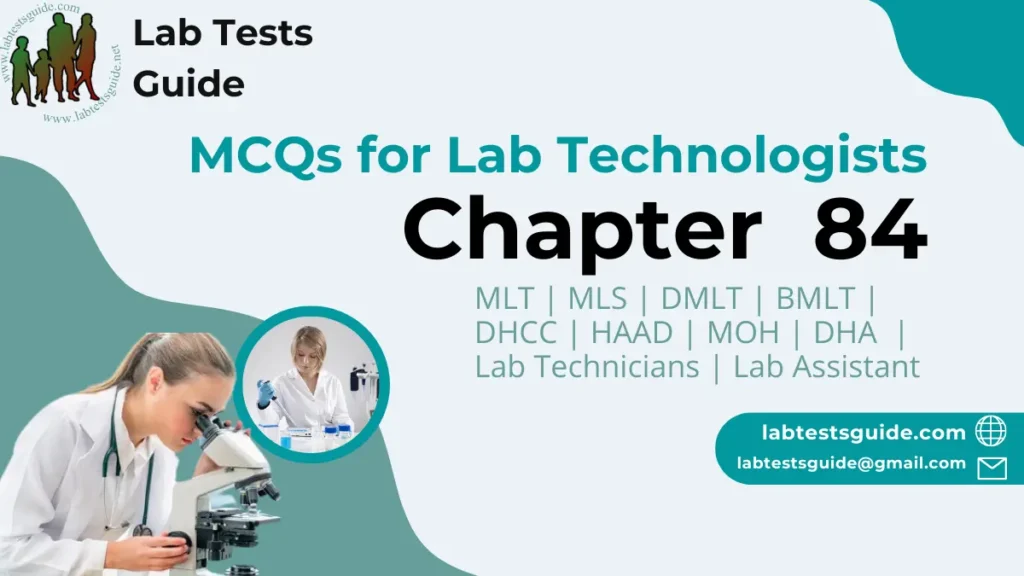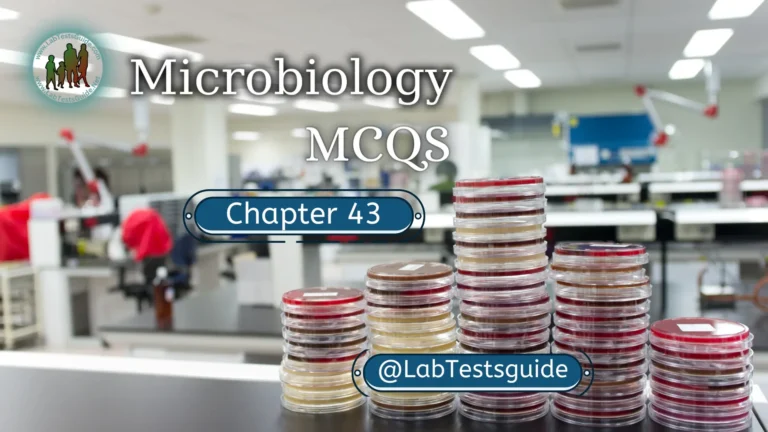5000 Plus MCQs for Lab Technician and Technologists are designed to test the knowledge and proficiency of laboratory professionals who work in the field of clinical laboratory science. These questions cover a wide range of topics related to laboratory science, including anatomy, physiology, microbiology, chemistry, and hematology.

4151 to 4200 MCQs for Lab Technician and Technologist Exam Preparation
If You like then share this to your friends and other social media.
If You have any question and suggestions then please Contact us Here
Questions 4151 to 4200
- What are motor neurons?
A. Unipolar
B. Pseudounipolar
C. Bipolar
D. Multipolar ✔️ - What type of epithelium forms the epidermis?
A. Simple squamous epithelium
B. Simple cuboidal epithelium
C. Simple columnar epithelium
D. Stratified squamous epithelium ✔️ - Which type of cartilage forms the epiphyseal growth plate?
A. Hyaline cartilage ✔️
B. Elastic cartilage
C. Fibrocartilage
D. All of the above - What percent of the matrix of cartilage is water?
A. 0
B. 10-40
C. 40-60
D. 60-80 ✔️
E. 80-100 - What type of tissue lines most of the gastrointestinal tract?
A. Simple squamous epithelium
B. Simple cuboidal epithelium
C. Simple columnar epithelium ✔️
D. Stratified squanmous epithelium - Which of the following is NOT a function of the liver?
A. Conversion of glucose into glycogen
B. Storage of glycogen
C. Storage of bile ✔️
D. Storage of fat soluble vitamins - Which layer of the epidermis has cells which have keratohyaline granules?
A. Stratum basale
B. Stratum spinosum
C. Stratum granulosum ✔️
D. Stratum lucidum - What are the basophilic clusters of ribosomes and rough endoplasmic reticulum seen in neurons called?
A. Ganglion
B. Perikaryon
C. Astrocyte
D. Nissl ✔️ - What is the cell body ofa neuron called?
A. Ganglion
B. Soma ✔️
C. Astrocyte
D. Nissl - Which of the following is composed of smooth muscle?
A. Upper esophagus
B. Heart
C. Tongue
D. Biceps muscle
E. Walls of the visceral organs ✔️ - During the preparation of a routine H&E slide, what allows tha tissue to hold its from?
A. Fixation
B. Embedding in paraffin ✔️
C. Staining
D. Slicing - What is a characteristic of the cells in the epidermis of the skin?
A. Microvilli
B. Stereocilia
C. Cilia
D. Keratinizationn ✔️ - What is woven bone?
A. Cancellous bone
B. Compact bone
C. Dense bone
D. Immature bone ✔️ - What do you call the space where a chondrocyte sits in?
A. Space of Disse
B. Space of Mall
C. Vacuole
D. Lacuna ✔️ - What is the portion of the nail which is underneath skin?
A. Lunula
B. Eponychium
C. Matrix
D. Nail bed
E. Root ✔️ - Which cell is a macrophage found in the central nervous system?
A. Kupffer cells
B. Histiocyte
C. Dust cell
D. Langerhans cell
E. Microglia ✔️ - Which cell is the mature bonecell?
A. Chondrocyte
B. Chondroblast
C. Osteocyte ✔️
D. Osteoclast
E. Bone lining cell - What type of epithelium appears stratified, but is not?
A. Epithelioid tissuue
B. Mesothelium
C. Endothelium
D. Transitional
E. Pseudostratified ✔️ - Which organelle containsdigestive enzymes?
A. Rough endoplasmic reticulum
B. Smooth endoplasmic reticulum
C. Lysosome ✔️
D. Golgi apparatus - Which structures are part of the portal triad?
A. Portal vein
B. Hepatic artery
C. Central vein
D. Sinusoids
E. Portal vein and Hepatic artery ✔️ - During the preparation ofa routine H&E slide, how is the preserved?
A. Fixation ✔️
B. Embedding in paraffin
C. Staining
D. Slicing - Which of the following is a member species of Mycobacterium tuberculosis complex-
A. M.ulcerans
B. M.gordonae
C. M.africanum ✔️
D. M.kansasii - Which of the following Mycobacterium is a causative agent of Buruli-ulcer –
A. M.avium intracellulare
B. M.xenopi
C. M.ulcerans ✔️
D. M.malmoense - Which of the following is NOT a characteristic of Mycoplasma-
A. They belong to the class Mollicutes
B. They require sterols for their growth
C. Their cell wall contains diaminopimelic acid ✔️
D. Their colonies have “Fried egg” appearance - Which of the following is NOT related to each other-
A. Ixodides tick and Babesiosis
B. Ixodides tick and Lyme disease
C. Ixodides tick and Endemic relapsing fever ✔️
D. Ixodides tick and Tularemia
- Which of the following is NOT true of Actinomyces-
A. These are strictly aerobic gram positive branching filaments ✔️
B. They produce sulphur granules
C. They cause Actinomycetoma
D. They are Non acid fast - Which of the following is a high level disinfectant-
A. Phenol
B. Gluteraldehyde ✔️
C. Iodophors
D. Chlorhexidine - Which of the following virus is NOT transmitted through blood-
A. CMV
B. HCV
C. BK virus ✔️
D. Parvovirus B19 - The maximum permissible bioload in an empty conventional operation theatre should be-
A. 10 bcp/m3
B. 35 bcp/m3 ✔️
C. 50 bcp/m3
D. 100 bcp/m3 - In hospital settings air conditioning ducts and cooling towers can be a source of hospital acquired Infection due to-
A. Methicillin resistant Staph aureus
B. Mycobacterium scrofulaceum
C. Legionella pneumophila ✔️
D. Aeromonas hydrophila - The proper biomedical waste policy for disposal of Human anatomical and animal waste would be-
A. Segregation in red bag and deep burial
B. Segregation in yellow bag and incineration ✔️
C. Segregation in puncture proof container and microwaving
D. Segregation in blue bag and autoclaving - Emerging and re-emerging infectious diseases are characterized by all, EXCEPT-
A. They have appeared for the first time or existed previously and presently increasing in incidence or
Geographical range
B. They have developed resistance to drugs
C. They are the result of increasing change in ecosystem, deforestation
D. They are seldom of Zoonotic origin ✔️ - All of the following are vaccine preventable diseases (VP), EXCEPT-
A. Measles
B. Hepatitis B
C. Dengue ✔️
D. Pertussis - Involution forms of bacteria are seen in-
A. Log phase of bacterial growth curve
B. Stationary phase of bacterial growth curve
C. Decline phase of bacterial growth curve ✔️
D. Lag phase of bacterial growth curve - Which mechanism of drug resistance to Tetracyclines is exhibited by bacteria-
A. Active efflux of antibiotic ✔️
B. Altered target enzymes
C. Poor transport across membrane
D. Altered ribosomal targets - By matching bacterial suspension with 0.5 McFarland turbidity standard corresponds to-
A. 0.5-1 X 10 5 cfu/ml
B. 1-2 X 10 8 cfu/ml ✔️
C. 2-3 X 10 8 cfu/ml
D. 1-2 X 10 5 cfu/ml - The Electron microscope was developed by-
A. Wright 1903
B. Frederick W. Twort 1915
C. Ernst Ruska 1934 ✔️
D. Frank Burnet 1957 - Which of the following is NOT true -..
A. Bollinger bodies are seen in measles virus infection ✔️
B. Negri bodies are seen in Rabies virus infection
C. Guarnieri bodies are seen in vaccinia virus infection
D. Cowdry type A bodies are seen in Yellow fever virus infection - Owl’s eye inclusion bodies are seen in-
A. Tanapox virus
B. Epstein Barr virus
C. Cytomegalovirus ✔️
D. Mumps virus - What type of muscle contains centrally placed nuclei?
A. Smooth muscle
B. Cardiac muscle
C. Skeletal muscle
D. Smooth muscle and Cardiac muscle ✔️
E. Smooth muscle, Cardiac muscle and Skeletal muscle - Which of the following layers comprise the skin?
A. Epidermis
B. Dermis
C. Hypodermis
D. Epidermis and Dermis ✔️ - Which organelle is involved in lipid metabolism?
A. Rough endoplasmic reticulum
B. Smooth endoplasmic reticulum ✔️
C. Lysosome
D. Golgi apparatus - What type of tissue makes up the “Adam’s apple”?
A. Hyaline cartilage ✔️
B. Fibrocartilage
C. Elastic cartilage
D. Hyaline cartilage and Fibrocartilage - Where is the site of protein synthesis?
A. Ribosomes ✔️
B. Peroxisome
C. Microfilaments
D. Centrioles - What is the lining of the inner bone on the side which abuts the medullary cavity?
A. Perimysium
B. Periosteum
C. Perichondrium
D. Perineurium
E. Endosteum ✔️ - Which fiber type is seen in smooth muscle?
A. Red fibers
B. White fibers
C. Internmediate fibers
D. All of the above
E. None of the above ✔️ - Which type of cartilage forms the skeleton of the fetus?
A. Hyaline cartilage ✔️
B. Elastic cartilage
C. Fibrocartilage
D. All of the above - Which meninx covers the brain intimately?
A. Dura mater
B. Arachnoid
C. Pia mater ✔️
D. Dura mater and Arachnoid - What forms the brush border?
A. Microvilli ✔️
B. Stereocilia
C. Cilia
D. Keratinization - Which sensory receptor in the skin is NOT encapsulated?
A. Ruffini endings
B. Free nerve endings ✔️
C. Pacinian corpuscles
D. Meissner’s corpuscles
The questions are typically designed to assess the technical skills and knowledge required for the laboratory profession, including the ability to analyze laboratory test results, perform laboratory procedures, and maintain laboratory equipment.
To prepare for these MCQs, candidates should have a thorough understanding of the key concepts and principles of laboratory science. They should also be familiar with common laboratory equipment and procedures, as well as laboratory safety protocols.
Candidates may also benefit from studying specific laboratory science textbooks or taking online courses that cover the material tested in the MCQs. Additionally, practicing sample MCQs and reviewing the answers can help candidates identify areas where they may need to improve their knowledge or skills.
Overall, the MCQs for lab technologists are designed to be challenging and comprehensive, requiring candidates to demonstrate a high level of proficiency in the field of laboratory science.
Possible References Used







